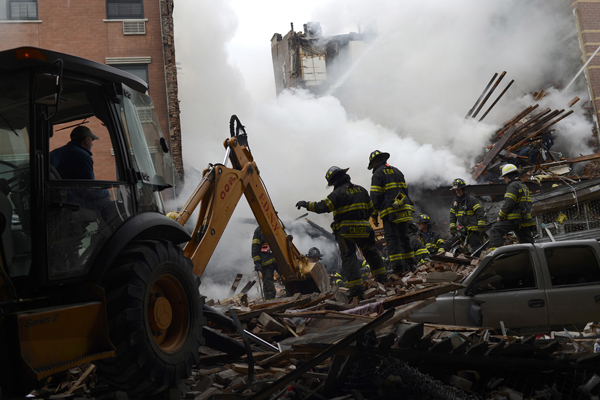
Photo by: NYC Mayor’s Office
Firefighters search through the rubble of two buildings in Harlem that exploded Wednesday morning. The death toll was expected to rise.
In 2011, City Limits published a detailed investigation of line of duty deaths among New York City firefighters across two decades. In multiple cases, the collapse of a building played a deadly role. Today’s tragedy in Harlem is a reminder of the catastrophic impact a building failure can have, and the episodes described in the excerpt below reflect the unique risks problems with building integrity pose for firefighters and other rescuers:
From “When Fire Wins: Causes of FDNY Deaths,” September 5, 2011:
When Buildings Fail
Firefighter Harry Ford used to play the lottery, and on one occasion this habit made him vulnerable to a practical joke in his Brooklyn firehouse. His buddies learned the numbers he’d played the night before and posted them on the bulletin board as that day’s winners. When Ford saw that he’d hit the jackpot, he addressed his brethren. “He said to them, ‘I’m out of here!'” and started up the stairs to clear out his gear. Suddenly sheepish that their joke had so totally fooled such a beloved friend, the guys broke the truth to Ford. He was, his wife says, totally unfazed. For one thing, he was pleased that “for 15 minutes I knew what it felt like to be a millionaire.” For another, Ford had never expressed a desire to do anything other than fight fires. He’d had a career as a grip on movie sets before joining the fire department—you can actually catch a fleeting glimpse of him in The Exorcist—and still did that work on the side. But he loved “the job,” talked of staying in the department for up to 35 years and never showed any interest in becoming an officer, despite getting encouragement to do so.
Ford was one of three firefighters who died in the infamous Father’s Day disaster—a cruel prelude in June 2001 to the mass death that awaited the FDNY family in September of that year. Along with Brian Fahey and John Downing, Ford responded to a fire at a hardware store on Astoria Boulevard. The fire was concentrated in a basement where paint and other chemicals were stored. Firefighters outside the building heard aerosol cans exploding in the heat and saw green and yellow smoke, but no one shared that information—which might have indicated an unusual fire was under way—to the chief in charge. Suddenly there was a strong smell of lacquer, and the building exploded, burying several firefighters and killing the three men.
Collapses have always been big killers of firefighters. [Legendary FDNY Chief Vincent] Dunn dedicated his 1988 firefighting book Collapse of Burning Buildings to the 46 FDNY members who’d were killed in collapses from 1956 to 1986. In the pages of Dunn’s book, the complexities of firefighting are laid bare, as Dunn describes the unique collapse risks of metal roofs, wooden structures, parapet walls, stairways and more. Saving your and your fellow firefighter’s life could require knowing the difference between a fire-cut beam and a mortise-and-tenon joint, keeping your foot on the hidden joist beneath a floor, or anticipating what’s behind the ceiling you are about to pull down.
In February 1996, Rescue 2’s Louis Valentino was killed in the collapse of a chop shop on Glenwood Road in Brooklyn. The incident commander had pulled firefighters off the roof out of fear of collapse but, since the fire looked about to come under control, did not call out the firefighters who were inside. Without warning, the ceiling collapsed.
Ten years later at a fire at a Bronx 99-cent store, firefighters were once again pulled off a roof but not from the interior. Suddenly, the floor collapsed, plunging 10 members into the cellar. Eight were saved, but Lt. Howard Carpluk and Firefighter Michael Reilly proved difficult to find. For an agonizing 30 minutes, Carpluk sent Mayday messages trying to direct his rescuers, as other firefighters clawed through stock from the 99-cent store or used sledgehammers to knock holes from an adjacent cellar into the one where the two men were trapped. “You gotta go 10 to 15 feet back from where they are working,” Carpluk radioed at one point. Reilly never made a sound. Their PASS alarms were not audible. The men were finally extracted after more than an hour and 20 minutes but did not live. The cellar had been illegally and shoddily repaired after an earlier fire, and the Bronx district attorney sought to prosecute its architect for certifying that proper building plans had been carried out. The architect, Jose Vargas, died before being tried.







